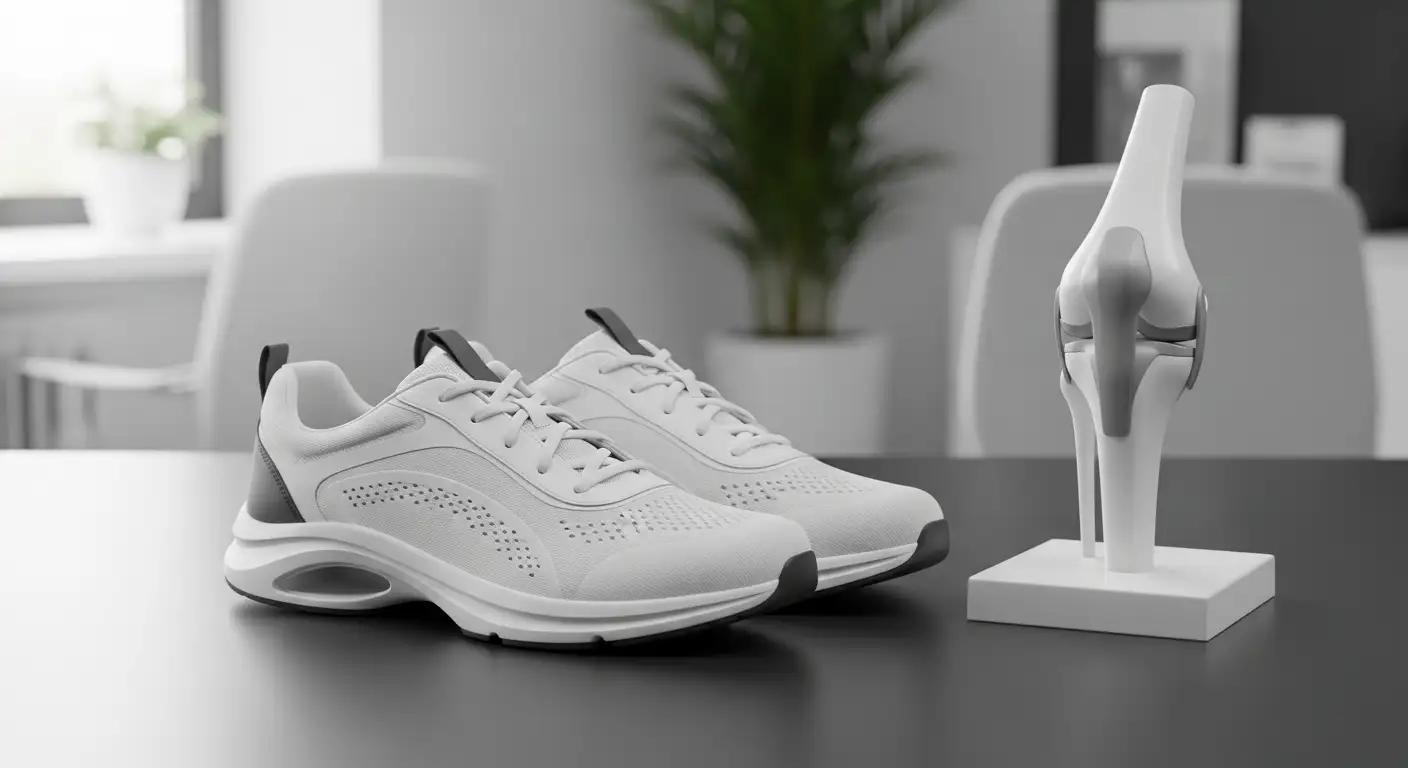Understanding Runner's Knee
Causes of Knee Pain
Runner's Knee, also known as patellofemoral pain syndrome (PFPS), can be caused by several factors. Improper tracking of the kneecap, where the kneecap does not move smoothly in the groove at the end of the thigh bone, is a common cause. Other contributors include excessive training volume without building adequate strength, muscular imbalances, particularly weaknesses through the hips and core, and improper footwear [1]. Ensuring proper form and wearing the right shoes can help in prevention.

Symptoms of Runner's Knee
Symptoms of Runner's Knee typically include dull pain in the front of the knee around the patella, where the knee connects with the thigh bone (femur). Individuals often experience pain when bending the knee, walking downstairs or downhill, and after sitting for extended periods [2]. Recognizing these symptoms early can aid in seeking appropriate treatment options.
For more information on managing knee pain at home, visit our guide on how to manage knee pain at home. Additionally, explore the best exercises for knee stability to strengthen the muscles supporting the knee.
Prevention Strategies
Implementing effective strategies for preventing runner's knee can help maintain knee stability and reduce the risk of injury. Here are key methods to consider:
Strengthening Exercises
Strengthening exercises are crucial for preventing runner's knee. By targeting the muscles around the knees, hips, and core, these exercises help in stabilizing the knee joint and enhancing overall leg flexibility. Research suggests that personalized physical therapy exercises focusing on quadriceps strength and flexibility are highly effective.
Key Exercises:
- Quadriceps Strengthening: Leg presses, squats, and lunges
- Hip-Stabilizing Exercises: Clamshells, lateral leg raises, and hip bridges
- Core Exercises: Planks, side planks, and bird dogs
For a comprehensive guide, visit our page on the best exercises for knee stability.
Maintaining Healthy Weight
Maintaining a healthy weight is essential to reduce stress on the knees. Extra body weight increases the load on the knee joints, exacerbating the risk of developing runner's knee. By keeping your weight within a healthy range, you can effectively decrease knee strain and enhance overall joint health.
Tips for Maintaining Healthy Weight:
- Balanced Diet: Focus on a diet rich in fruits, vegetables, lean proteins, and whole grains.
- Regular Exercise: Engage in regular physical activities, such as walking, swimming, or cycling.
- Hydration: Drink ample water to keep your body well-hydrated and support metabolic functions.

Proper Footwear
Wearing the right footwear is crucial for preventing runner's knee. Proper shoes provide adequate support, cushioning, and stability, which are vital for maintaining proper form while running [5]. It's essential to choose shoes that cater to your specific foot type and running style.
Shoe Features to Consider:
- Cushioning: Look for shoes with good cushioning to absorb impact.
- Support: Ensure the shoes provide proper arch support and heel stability.
- Fit: Choose shoes that fit well and offer enough room for toe movement.
For more details on selecting the right shoes, check out our guide on choosing the right shoes.
By integrating these prevention strategies into your routine, you can significantly reduce the risk of runner's knee and maintain healthy, stable knees. For additional tips on managing knee pain, visit our page on how to manage knee pain at home.
Treatment Options
When dealing with runner's knee, various non-surgical treatment options are available to help alleviate pain and promote recovery. These include rest and ice, physical therapy, and medication or injections.
Rest and Ice
One of the primary steps in treating runner's knee is to rest and apply ice to the affected area. Resting involves cutting back on running or any activities that exacerbate the pain. Applying ice can help reduce swelling and alleviate pain. According to Healthline, pain may subside in two to three weeks with adequate rest and ice application.
For additional tips on how to manage knee pain at home, consider integrating these methods into your daily routine.
Physical Therapy
If pain persists despite rest and ice, consulting a physical therapist is advisable. A physical therapist can recommend specific strengthening and stretching exercises tailored to aid recovery. These exercises often focus on improving muscle strength around the knee, enhancing knee stability, and promoting proper alignment. For more targeted exercises, explore our article on best exercises for knee stability.
Medication and Injections
In cases where pain and swelling are severe, medication and injections might be necessary. Over-the-counter pain relievers like ibuprofen and acetaminophen can help manage pain and reduce inflammation. For more persistent symptoms, an orthopedic sports medicine specialist may recommend knee joint injections or, in rare cases, arthroscopy [2].
By understanding and implementing these treatment options, individuals can effectively manage runner's knee and work towards a full recovery. For more information on pre-surgical care, visit our section on preoperative care for knee surgery. Additionally, consider exploring winter activities for knee pain sufferers to stay active while managing knee pain.
Importance of Strengthening
Strengthening the muscles around the knees, hips, and core is essential for preventing runner's knee. This section explores the importance of targeting specific muscle groups to enhance knee stability.

Hip-Stabilizing Muscles
Weak hip-stabilizing muscles can place increased force below the knee, contributing to knee injuries in runners. Strengthening these muscles helps distribute the impact evenly and reduces stress on the knee joint.
Key Exercises:
- Side-Lying Leg Raises: Targets the gluteus medius, a crucial muscle for hip stabilization.
- Clamshells: Activates the hip abductors and enhances lateral stability.
Quadriceps Strengthening
The quadriceps play a significant role in knee stability. Strengthening these muscles can help prevent and treat runner's knee. A 2007 study found that personalized physical therapy exercises focusing on quadriceps strength were more effective than knee braces or taping.
Key Exercises:
- Squats: Enhance overall leg strength, focusing on the quadriceps.
- Leg Press: Targets the quadriceps with controlled, isolated movements.
Core and Hip Exercises
A strong core and hips are vital for maintaining proper running form and reducing the risk of knee injuries. Strengthening these areas helps in stabilizing the pelvis and minimizing undue stress on the knees.
Key Exercises:
- Planks: Strengthen the core muscles, essential for overall stability.
- Bridges: Target the glutes and lower back, enhancing hip strength.
Incorporating these exercises into a regular routine can significantly improve knee stability and help prevent runner's knee. For more detailed exercise routines, visit our page on best exercises for knee stability. Additionally, maintaining a healthy weight can reduce stress on the knees, further preventing knee pain. For more tips on managing knee pain, check out our guide on how to manage knee pain at home.
Best Practices for Runners
To prevent knee injuries and enhance performance, runners should adhere to best practices that support knee stability. Incorporating warm-up routines, managing running frequency, and understanding foot strike patterns are essential steps.
Warm-Up and Stretching
Warming up and stretching are crucial for preventing knee pain and ensuring overall joint health. A proper warm-up increases blood flow to the muscles and prepares the body for physical activity. According to Healthline, a light jog before running helps to loosen muscles and joints, reducing the risk of injury.
Key warm-up and stretching tips:
- Start with a 5-10 minute light jog.
- Perform dynamic stretches like leg swings and walking lunges.
- Incorporate static stretches post-run, targeting the quadriceps, hamstrings, and calves.
For additional tips on exercises that enhance knee stability, visit our guide on best exercises for knee stability.
Running Frequency
Managing how often and how much you run is vital for preventing knee injuries. Running over 40 miles per week can increase the risk of knee pain [6]. Most individuals should aim to run no more than four or five days per week, with one or two rest days to allow for muscle recovery.
Recommended running frequency:
- Run 3-5 times per week.
- Include at least one rest day.
- Engage in cross-training activities like cycling or swimming on non-running days.
For more information on managing knee pain, check out our article on how to manage knee pain at home.
Foot Strike Patterns
The way your foot strikes the ground while running can impact knee health. Research suggests that runners who land with a rear-foot strike (hitting the ground with the back of the foot first) are at a higher risk for repetitive stress injuries [6]. Adopting a mid-foot or forefoot strike can help distribute the impact more evenly and reduce stress on the knees.
Foot strike patterns to consider:
- Rear-Foot Strike: Higher risk of knee injuries.
- Mid-Foot Strike: Distributes impact evenly.
- Forefoot Strike: Reduces stress on knees, but may increase strain on calves and Achilles tendon.
For additional strategies on preventing knee pain, explore our article on winter activities for knee pain sufferers.
By following these best practices, runners can minimize the risk of knee injuries and maintain healthy joints. Incorporate warm-up and stretching routines, manage running frequency, and optimize foot strike patterns to run with confidence and prevent runner's knee.
Choosing the Right Shoes
Selecting the right running shoes is crucial for preventing Runner's Knee. The appropriate footwear can offer the necessary support and cushioning to reduce stress on the knees.
Shoe Features to Consider
When choosing running shoes, consider the following features to help prevent Runner's Knee:
- Arch Support: Proper arch support helps in distributing pressure evenly across the foot.
- Cushioning: Good cushioning absorbs the impact of each step, reducing stress on the knees.
- Stability: Stability features help control excessive foot motion, which can contribute to knee pain.
- Heel Drop: A moderate heel drop (the difference in height between the heel and the toe) can help maintain a natural foot strike.
- Fit and Comfort: Ensure the shoes fit well and are comfortable to avoid blisters and other foot issues.
- Foot Strike Assessment: Understanding whether you are a heel-striker, mid-foot striker, or forefoot striker can guide you in selecting the most suitable shoes.
- Insoles: Custom or over-the-counter insoles can provide additional arch support and cushioning.
- Recovery Slides: These can offer extra support and cushioning post-run.
For more information on the best exercises to complement your shoe choice, visit our article on best exercises for knee stability.
Signs of Worn-Out Shoes
Monitoring the condition of your running shoes is essential. Worn-out shoes can significantly contribute to knee injuries. Here are signs to look for:
- Mileage: Replace shoes every 400 to 600 km (approximately 250 to 375 miles).
- Wear and Tear: Look for visible signs of wear on the outsole and midsole.
- Loss of Cushioning: If the cushioning feels compressed or less responsive, it's time for a new pair.
- Decreased Stability: If the shoes feel less stable or supportive, they may have lost their structural integrity.
Keeping track of these signs can help you know when it’s time to invest in a new pair of running shoes. For tips on managing knee pain at home, see our guide on how to manage knee pain at home.
Recommended Shoe Models
Different shoe models cater to various needs and preferences. Here are some highly recommended options:
These models are designed to provide the necessary support and cushioning to help prevent Runner's Knee. For more insights on winter activities that are knee-friendly, check out our article on winter activities for knee pain sufferers.
References
[1]: https://www.blacktoerunning.com/blogs/education/how-to-pick-shoes-for-runners-knee
[2]: https://orthopedicnj.com/news/what-is-runners-knee
[3]: https://www.healthline.com/health/exercise-fitness/runners-knee-exercises
[4]: https://www.webmd.com/pain-management/knee-pain/runners-knee
[5]: https://www.cedars-sinai.org/health-library/diseases-and-conditions/r/runners-knee.html
[6]: https://www.healthline.com/health/exercise-fitness/running-tips-knee-stretches





